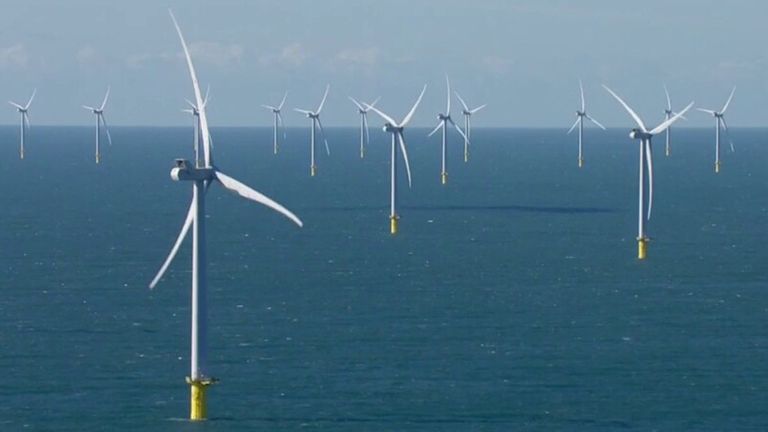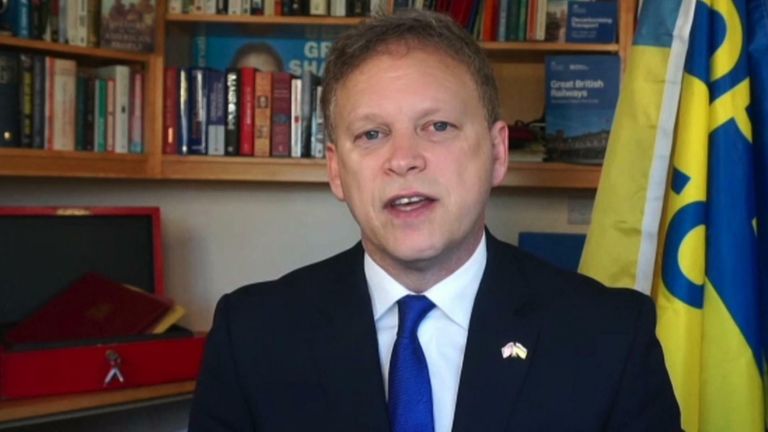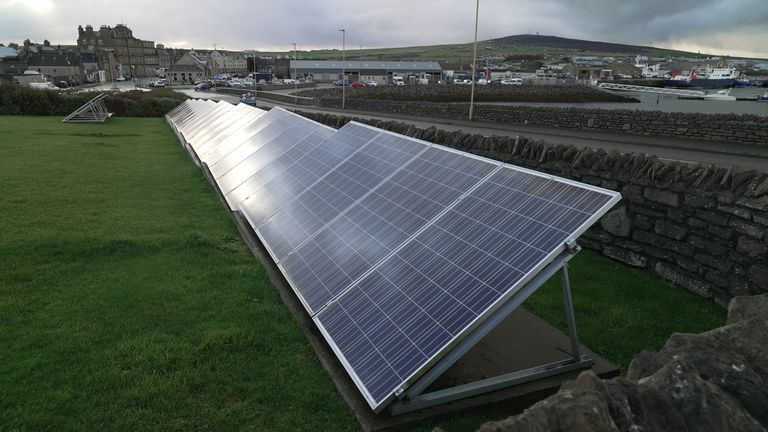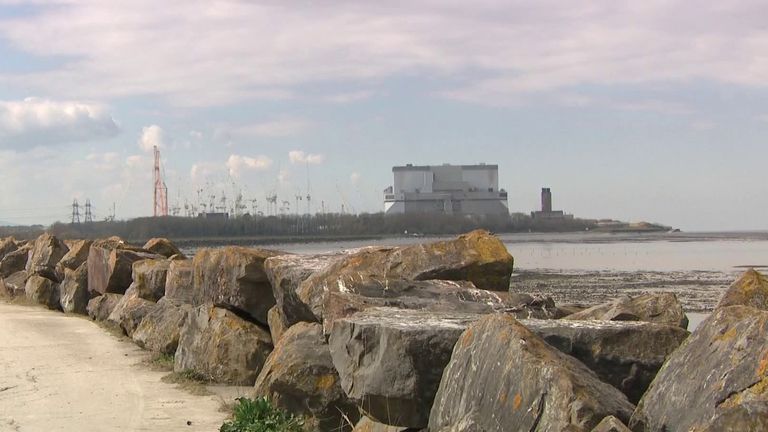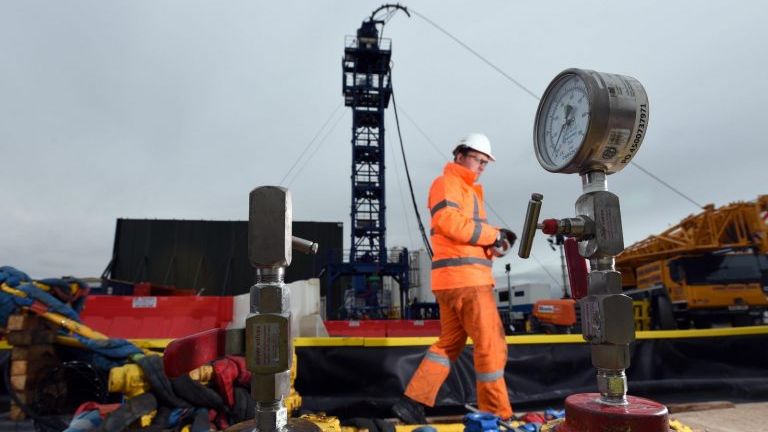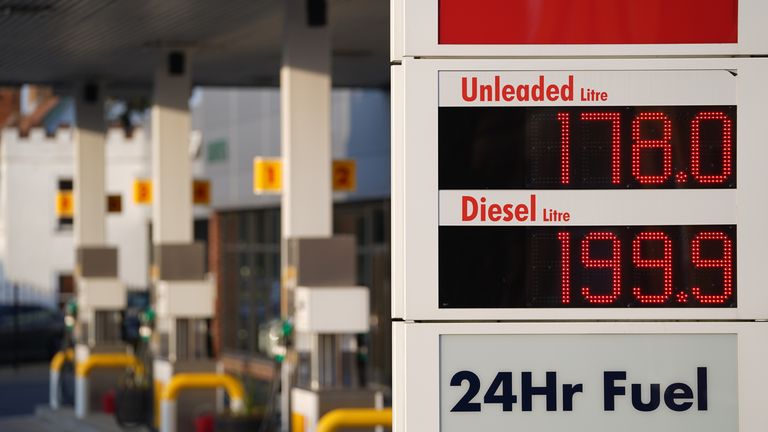Nuclear and windfarms: What is in the energy security strategy?
A new strategy for how the UK will produce more of its own energy has been unveiled in full after several delays.
The government has published the “Energy Security Strategy” to help tackle soaring energy prices and reduce reliance on Russian oil and gas.
Nuclear power forms a key part of the plan, with offshore wind, solar and hydrogen also featuring as the government targets 95% of electricity being low carbon by 2030.
Prime Minister Boris Johnson said the government is “already stepping in to help” when it comes to household energy bills, with more than £9bn of help for struggling families.
“But if we’re going to get prices down and keep them there for the long term, we need a flow of energy that is affordable, clean and above all secure,” he wrote in the foreword to the strategy.
“We need a power supply that’s made in Britain, for Britain – and that’s what this plan is all about.”
But critics say there are some key issues the government is failing to address.
What’s happening about bills?
The government has already separately announced plans to tackle soaring costs, with the average family’s energy bills rising by 54%.
As wholesale energy prices have risen, the typical energy price cap for millions of households has been raised to £1,971 and is expected to rise again in October to about £2,300.
In an attempt to dampen the blow, the government is offering a £200 discount on all household bills from October, which will be paid back over five years.
And homes in council bands A-D will get a £150 discount on their council tax bill this month.
The government says its new longer term strategy for “homegrown” energy will protect Britain from some of the international price volatility behind the bill hikes, meaning they will be lower than they would have been without its intervention.
Read more: Will a move to renewables save us money on our energy bills?
Windfarms
Renewable energy play a significant role in the plan, especially wind farms.
The goal for offshore wind generation is being ramped up, with an increase of the current target to generate 40GW – 25% of the UK’s energy – by 2030, to 50GW.
The government says this would be more than enough to power every home in the UK, and would include 5GW from floating offshore wind in deeper seas – underpinned by planning reforms to speed up their development.
But on onshore windfarms, over which the cabinet is split, there has been no headline announcement on the relaxing of current strict planning rules.
Instead, there will be a consultation on “partnerships with a limited number of supportive communities” for the building of turbines in exchange for guaranteed lower energy bills.
Business Secretary Kwasi Kwarteng has reportedly been looking to double onshore wind power by 2030 and treble it by 2035 but Transport Secretary Grant Shapps told Sky News: “I don’t favour a vast increase in onshore wind farms.”
Mr Johnson’s spokesman said onshore turbines should be built when “locally supported”. The PM, however, appears to have shifted his support to offshore wind over concerns about onshore from colleagues.
Solar power
For solar power, there will be a consultation on the rules for projects, particularly on domestic and commercial rooftops, the government said.
In Chancellor Rishi Sunak’s spring statement in March, VAT on solar panels for homes was cut from 5% to zero for the next five years.
The aim is to see the current solar capacity of 14GW grow up to five times by 2035.
Mr Johnson earlier this month wrote: “We will do more to exploit the potential of solar power. Even in this country, solar power is remarkably cheap and effective.
“We will modernise our grid and our distribution networks.”
Nuclear power
A large focus is placed on nuclear power, including plans for building smaller modular reactors that take less time to construct.
The government said up to eight reactors could be delivered by 2030 – accelerating the pace from one a decade to one a year.
The focus on nuclear would build on the development of Hinkley Point C in Somerset, currently under construction, and talks to develop Sizewell C in Suffolk – between them set to generate 6.5GW of power.
A new body, Great British Nuclear, is being set up to bring forward the development of new sites, backed by “substantial funding”, while a £120m “future nuclear enabling fund” is to be launched this month.
The government said it would work to kick off a series of projects as soon as possible, including at Wylfa in Anglesey.
Its ambition is for up to 24GW to come from the “safe, clean and reliable source of power” by 2050, about 25% of expected demand, with a fleet of smaller reactors forming a key part of the pipeline.
Hydrogen
Mr Kwarteng tweeted on Tuesday: “We’re set to generate 5GW [of hydrogen] this decade, but we will go further in this week’s energy security strategy.”
The target is now being doubled to 10GW, with the aim to provide cleaner energy for industry as well as for power, transport and potentially heating.
There will also be a £30m “heat pump investment accelerator competition” to make British heat pumps – an alternative to gas boilers.
Subscribe to ClimateCast on Spotify, Apple Podcasts, or Spreaker
North Sea and Middle East oil and gas
Ministers want to wean the UK off oil and gas from Russia as part of an interim plan to reduce reliance on hydrocarbons altogether.
They will seek to expand the UK’s own gas and oil supplies by pumping more from the North Sea, with the issuing of licences for new projects to be brought forward to this summer.
MPs are meanwhile expecting to hear what the outcome is of ministers’ recent talks with Middle Eastern suppliers such as Saudi Arabia. Labour has accused the government of going “cap in hand” to dictators over the approach.
Fracking
The government made a dramatic U-turn on its position on fracking in 2019, when it put a moratorium on the practice that pumps water, chemicals and sand underground at high pressure to fracture shale rock and release trapped oil and gas.
Its decision came after a new scientific study warned it was not possible to rule out “unacceptable” consequences for those living near fracking sites.
But fracking has raised its head again as the government tries to secure its own supplies and reduce energy bills, with the PM voicing support for a halt to projects to seal off the UK’s two remaining wells.
Brexit opportunities minister Jacob Rees-Mogg downplayed the earthquake risks from fracking on Monday and suggested “every last drop” of oil should be extracted from the North Sea.
On Tuesday, Mr Kwarteng announced he has commissioned the British Geological Survey to “advise on the latest scientific evidence around shale gas extraction”.
He later said: “There is no way we can do this without a large measure of community consent, that’s always been a principle and there’s no way we can do it if it isn’t safe.”
Downing Street appeared to not rule fracking out as it said the moratorium “still remains” but said the Ukraine war means the government needs to “look at all possible options for improving domestic energy supply”.
Read more: Licence for controversial North Sea oil and gas field extended
However, energy minister Greg Hands said: “Fracking is not the solution to near-term issues.”
Fracking was not among the headline announcements as the strategy was unveiled.
Coal
The PM has committed to ending coal-fired power generation by October 2024, but The Times reported Number 10 is in discussions with EDF to assess whether its Nottinghamshire power plant, due to close in September, could extend operations.
Are there other issues the government could be looking at?
Labour has said the government should also be addressing insulation as a way of saving energy and reducing bills, but the Treasury and other departments have ruled this out.
The opposition party said it would upgrade 19 million homes to make them warm, energy efficient and cheaper to heat if it was in power.
Shadow environment secretary Jim McMahon said the Conservatives are “allowing taxpayers to bear the brunt of spiralling costs” after changes to energy efficiency programmes in 2013 saw installations drop by 92% that year, according to a Carbon Brief report.
Labour and the Lib Dems have proposed a windfall tax on fossil fuel companies so their large profits can be used to ease energy bills for vulnerable people.
However, the government has ruled this out as it said it would stop companies investing and those oil and gas companies employ thousands in the UK and support thousands more British jobs.

